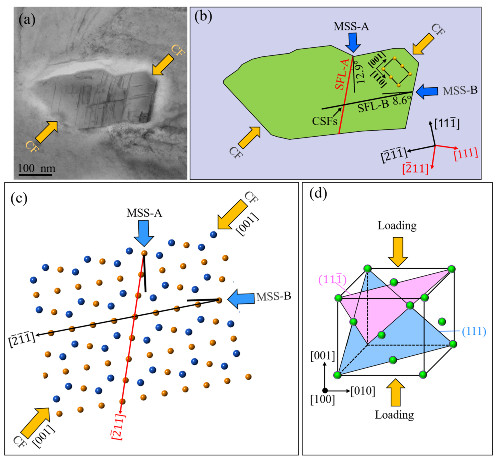Defects exist in a variety of crystals. Stacking faults (SFs), as a common type of planar defects in crystal, are among important microstructure components of crystal with a low associated energy during plastic deformation or irradiation. SFs are mostly related to the glide of partial dislocations contributing to the strengthening of metals and alloys. For close-packed crystal structures, SFs are formed as partial dislocations (1/6<112> and 1/3<1100> partials for face-centered cubic (FCC) and close-packed hexagonal (HCP) structures, respectively) that nucleate and glide on the close-packed crystallographic planes ({111} and {0001} planes for FCC and HCP structure, respectively). It is interesting that the {111} family of FCC structures includes four crossed close-packed planes. If the dislocations originate on the crossed close-packed planes simultaneously, cross slips or cross stacking faults (CSFs) would be triggered.
Recently, Prof. LI Geping’s group from Titanium Alloys Division of Institute of Metal Research, Chinese Academy of Sciences (IMR, CAS) discovered that FCC (C15) Laves phase (Zr(Fe,Cr)2) nanoparticles in Zircaloy-4 alloy with shear deformation often contain CSFs. In addition, the CSFs were formed on the crossed closed-packed planes. The structure of SFs on every close-packed plane is that HCP domain structure was induced in the SFs region. In addition, owing to unique structure of the Laves phase, these domain structures were formed by Synchroshear.
Furthermore, Prof. LI Geping’s group paid more attention to the formation mechanism of the CSFs. The driving force of dislocations for the α-Zr matrix was parallel to the [001] direction of the nanoparticle by identifying the dislocations in the the α-Zr matrix. And then combine with the shape of the nanoparticle, which can be assumed to experience uniaxial compression during the shear deformation and the compression direction was parallel to the [001] direction. It is known that the maximum shear stresses (MSS) are located on the planes with their normal directions 45° away from the compression direction. The angle between SFs lines and MSS planes were less than 12.9°. In other words, the crossed close-packed planes of FCC structure obtained large resolved shear stress simultaneously with the external load parallel to [001] direction contributing to the CSFs.
The model presented above can be extended to the formation of CSFs in general FCC structure and provide a whole new understanding of the CSFs.
The study entitled ‘Cross stacking faults in Zr(Fe,Cr)2 face-centered cubic Laves phase nanoparticle’ has been published in the journal Applied Surface Science. (DOI: /10.1016/j.apsusc.2020.145716).

Figure 1. Schematic of the model for Cross stacking faults nucleation and growth in FCC Laves phase nanoparticle. (Image by IMR)